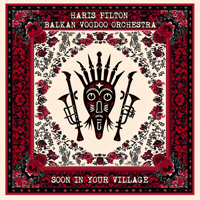
HARIS PILTON & THE BALKAN VOODOO ORCHESTRA
SOON IN YOUR VILLAGE (Asphalt Tango DIG-ATR9125)
This is not world music, so-called, it's otherworldly or between worlds. Balkan yes, but with a heavy dub vibe. The music is ancient and futuristic, from familiar Balkan brass ensemble riffs to twangy psychedelic touches thrown over it, to a big hall echo where other sounds can be discerned in the background as if there is a house disco party at one end and a rock concert at the other. There are voices, guitars and a lot of pulsating drums. Some of the tracks sound familiar, either remakes or sampled from other Balkan beat albums, like "Balkan King Dance." I think it's "Carolina" by Taraf de Haiduks. "Shake your mustache" featuring Stereo Partizan reminded of something, maybe "Iest Sexy" by Mahala Rai Banda. There are four guests, the only one I have heard of is La Cherga who appear on "Last Train to Chaosville." "Brass Caravan" starts atmospherically, and kicks in with dubby intent over a background wash of a cheering crowd. Appropriately, as it's the centenary of the death of Satie, this one is a synthi remake of Gnossienne no 1. "Gnosienne" means little know-it-all; so now ya know! However this version is blaring and overcooked, lacking in all subtlety. But there is a lot of a variety which makes this set mostly interesting. "Fiesta Tungusia" has a riff I know from somewhere in Cumbialand... ah yes it's "La Colegiala" by Rodolfo y su Tipica! There is a wan vocal which sounds like a Bollywood lovelorn ballad behind the chugging rhythm. In total contrast, this is followed by Doggy Brasco who sings like Laibach as he crunches through St James Infirmary Blues, retitled "No Brass, no Love."
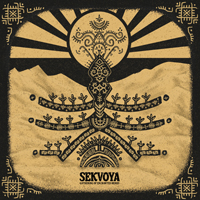
SEKVOYA
GATHERING OF ENCHANTED HERBS (Zero Nove Nove)
The echoey Farfisa on this immediately put me in mind of Country Joe & the Fish and consequently made me feel a little high and dreamy. This goes to show you don't need drugs when music can produce an altered state of mind! The group come from Novi Sad, Serbia (the very name sounds depressing) and channel a mix of psychedelia, Balkan "world beats" with homegrown Anatolian rock. Their name comes from the Sequoia tree (which was named after a Native American chief) which is among the oldest living things on earth and according to the bandleader, Ivan Krstics, contains ancient memories. Some were transplanted and grown in Serbia. Finding peace through connecting to nature gets my vote. The music is jazzy, hip and informed. Krstics cites various influences: Altin Gün, Bab L'Bluz, even the desert blues of Tinariwen and Mdou Moctar (which I can't hear); I find it original and refreshing. This 5-track EP is the first of a projected trilogy. Check out their debut single "Snake Charmer."
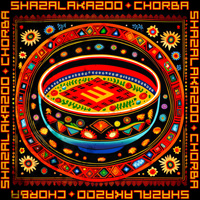
SHAZALAKAZOO
CHORBA (Asphalt Tango Records ATR-DIG8124)
This digital-only release comes from the distinguished German label Asphalt Tango who have brought the best of Balkan music to us for nigh on 30 years: from modern bands like Fanfare Ciocarlia, Jony Iliev, Mahala Rai Banda, Kottarashky and Motion Trio to classics of the bygone age such as Ion Petre Stoican, Toni Jordache and Gabi Lunca — it is a deep catalogue full of musical wonder and excellence. Now they present the fifth album from a horn & synth duo who blend Balkan sounds with gypsy melodies and electronica: ShazaLaKazoo. In addition there are other Middle Eastern elements: their new lead singer/rapper is Aimilia Varanaki, a Greek woman who also plays violin. It's uptempo and disco-ish with the trumpet on stereo chorus and martial drum tracks to have you dancing in a circle waving your hanky. The Serbian trumpeter also plays valve trombones; in addition we hear "wind synth" and of course "programming." "Chorba" is a soup or stew widely consumed in the Middle East and North Africa. I wish I hadn't mentioned that because now I am hungry. So back to the beat where there is break tempo and half-rapped lyrics, reminiscent of Shakira, on "Moriria," sung in Spanish, but it's more disco than cumbia. "Desafino (out of tune)" seems to be in Greco-Spanish. It's a dense disc but doesn't make a deep impact. Now where is that lamb stew?
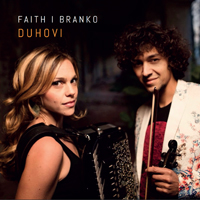
FAITH I BRANKO
DUHOVI (Riverboat TUGCD1134)
Riverboat is a label with a solid track record of turning up lesser-known artists who are nevertheless great, or on the verge of a breakout. This is the second album of Faith i Branko and showcases a very accomplished set of Roma-inspired gypsy music. Faith was born in the UK. 15 years ago she met and married Serbian Branko Ristic. She plays accordion; he is a violinist. Faith also sings and plays synth and tabor pipe, which is a tiny three-hole whistle-like flute. The title "Duhovi" means ghosts, and refers to four of the musicians on the album who passed away since it was started in Emir Kusturica's studio in Serbia. There is a kind of "Spinal Tap" morbidity to their identification on the album, as "guitar (track 1) deceased," "guitar (track 2) deceased," "guitar (track 14) deceased," etc. Now Faith and Branko live in London and their music reflects a pan-cultural approach, right from the outset, with "Mari Lon," which is a gypsy number based on an (unidentified) Bollywood movie song. From there they traveled to Penrith, which is in northwest England, where they had a residency and jammed with Iranian Pouya Mahmoodi, guitar (still extant), who improvises wildly adding a John McGlaughlin-esque flourish to their rave up. The album ends with another casualty: Uncle Milo who sings (croaks, actually) and beats up his broken guitar. It's telling us something, I am not sure what, though a lot of the folk on this session seem to have caught Covid-19. Milo died during the pandemic and whatever talent he had formerly possessed is another ghost on this adventure. The title cut, "Duhovi," is a tour-de-force of violin playing and Branko also shines on Faith's star turn "I'm sorry," but together they display massive talents. They have a video of the track "Irena Kolo," on Youtube.
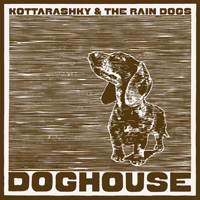
KOTTARASHKY & THE RAIN DOGS
DOGHOUSE (Asphalt Tango DIG-ATR7022)
The latest slice of life from Bulgarian artist Kottarashky is quite vivid compared to the picture we have of Bulgaria and Eastern Europe in general as relentlessly drab. This is his fourth album of high energy dance music and meditative jazz soundscapes. As you'd expect from Balkan music there is accordion and trumpet, but there are elements of blues and jazz, and even trip hop drumming grafted onto Bulgarian folk music. I also hear tango in the accordion, and why not. In fact, there are few of your typical Balkan beats: it's something unique and much looser, more fluid. There is a new crooner in the band, a New Zealand singer called Tui Mamaki who started in France, visited India, and ended up in the Balkans, in her musical explorations. She fares better than the lounge singing of Kottarashky with his lyrics like "Fuck you very much," which is not cute, but Tui plus the accordion are excellent. Sax takes the lead on "Drunken fish," which has nice sloppy drumming. Flute adds a nice layer to "Hare Nishto," which I guess has Indian inspiration. The trumpets and saxes also get to show their chops in this varied and very engaging set of original tunes.
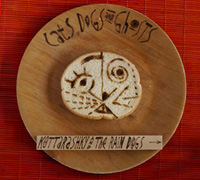
KOTTARASHKY & THE RAIN DOGS
CATS, DOGS & GHOSTS (Asphalt Tango CD-ATR 5516)
Kottarashy started out as a drum'n'bass DJ with loops based on old gypsy records. His debut album Opa Hey! was really catchy. But he took his musical ideas to the next level by getting together a band and now on his third album they take on rock'n'roll, blues, jazz and what must be Balkan funk. Dimitar Liolev is outstanding on sax and reeds, joined by tenor trombone and clarinet occasionally. In addition to guitar, bass and traps there's a synth on two tracks, and Kottarashky himself, behind the curtain, with effects and samples. After some meanders we get to the excellent "Fuga," with fast drums and Bulgarian flute and some Looney Tunes stop/start breaks with xylophone and percussion. Also "September" with its moody baritone sax (or is that a bass clarinet?) and poppy keyboards clicks. Sadly there's a rap track, "Mission completed," which i will pretend did not happen. But they won't let me forget it as the rapper Nufry takes over on "The winner, the driver." Still, with two tracks deleted, the truncated album works for me.
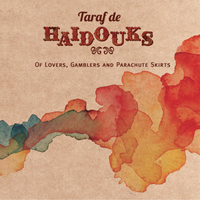
TARAF DE HAIDOUKS
OF LOVERS, GAMBLERS AND PARACHUTE SKIRTS (Crammed Discs)
Those Lautari zanies are back, resurrected reformed and full of piss and vinegar. It's actually a new generation of the franchise on this their sixth album, many of the original members having gone to their eternal rest. The four oldest singers have died and for the first time the new recruits are revisiting some of the classics from the repertoire of Romanian ballads and Gypsy love songs, along with the Turkish delight flavored instrumentals they excel at. The lavishly illustrated booklet accompanying this new release shows some of the original members posed in a group shot of musicians from Clejani in 1970. The new recruits are sons of original members who picked up the tunes at their fathers' knees, and Viorica Rudareasa, who sang "Dumbala Dunba" has been re-enlisted into the ranks to sing on four tracks. Her voice is unmistakable and you'll enjoy the translated lyrics of "De unde vi tu, mai lele (Where do you come from, dear lady)?" Now who can forget the funeral of Nicolae Neacsu in Elsa Dahmani's film No Man is a Prophet in his own Land? But before he died he passed on his violin bow-string shredding technique to a younger player. You hear it here on the eerie "Nici nu ninge, nici no ploua (No snow, no rain)." There is flute (Falcaru, still active) accompanying Gheorghe, son of the late Ion Manole, who performs as a street singer in Western Europe. He has memorized a huge repertoire of the old Clejani songs. The band was actually formed in 1990, around the time Tony Gatlif came to Clejani to find real Lautari for his documentary, Latcho Drom -- unquestionably one of the best films ever made about music, and up there with The Girl Can't Help It, Fez: Sound of Soul or the fictional Cadillac Records. (I try to catch them all, from The Runaways to Behind the Candelabra, and if they were good you'd be the first to know.) The new band is in fine form here, with great drunken stop-time rickety rhythms on Ionica's cymbalum as an accordion blows counterpoint to the violin's sad lament, while the double bass tiptoes upstairs to the attic in "The High Balcony in Ciolpan."
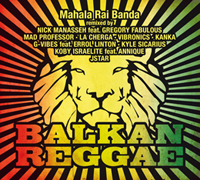
MAHALA RAI BANDA
BALKAN REGGAE (Asphalt-Tango CD ATR-3713)
This album is so good I have to complain about the length. It's only half an hour and when you subtract the irritating song which can only be listened to once, it comes it at under 30 minutes. Mahala Rai Banda are one of the legendary gypsy bands, but they have an added plus. In addition to the regular Gypsy instruments of cembalom, violin and accordion, they've added a brass band. Formed in 2004, the Gypsy members were young relatives of the famous Taraf de Haïdouks (Band of Brigands) who (since they were living in Bucharest) wanted more of an urban edge and teamed up with some Moldovan army brass veterans. They've also been remixed before, on their debut disc, as well as the fabulous Electric Gypsyland, which we all know and love, with the classic "Iest Sexy." This time out they are in dub mode, with some reggae toasters popping up. There's only one track reworked by several bredren and sistren. That's my first gripe: I could have used an hour of this, and more tracks. The master piece is "Balkan Reggae" which was on their Ghetto Blasters album. Cembalom doesn't sound that far different from the funky Hohner clavinet on echo that was a part of many classic reggae recordings, and the accordion, similarly treated, is very familiar, sounding a lot like Augustus Pablo's melodica. Funnily enough I was thinking one of the riffs sounded like "Three Blind Mice," then thought, "that's the perfect Augustus Pablo tune!" But we don't even have to go to Kingston, if we hear what the man Errol Linton says, "From Brixton to Bucharest -- they are the best!" Interestingly none of the Mahala Rai Band speaks English (and of course none of the British DJs involved in the project speak Romany). Track 7 by singer Annique and Koby Israelite (on accordion) is the one I had to mute. Sometimes an artist is just a pretty face. It's not awful but her vocal spoils the mood -- English can be a hindrance sometimes! Koby Israelite also has a debut album out which I tried listening to but it's mostly rock and roll with the novelty of accordion as lead instrument. The bonus track, a cover of Led Zep's "Kashmir," is a curiosity, but I doubt you'd listen to it more than once. So yes this great album has its annoying moments and it's too short, but other than that, I love it!

KOTTARASHKY AND THE RAIN DOGS
DEMONI (Asphalt Tango CD-ATR3312)
Kottarashky (real name Nicola Gruev) built a reputation as the Balkan beatmeister, DJ-ing with folk samples and a stripped down sensibility and now he has taken the next logical step: gotten himself a live band. The Rain Dogs are made up of old friends and musicians from the club scene in Kottarasky's native Sofia. They are more blues than gypsy, more Tom Waits than Ivo Papazov, yet they still have that Balkan groove underpinning their sound. As befits a mix-master, the bass and drums are heavy: here held down by Yordan Geshakov and Atanas Popov. The stars are clarinetist Aleksandar Dobrev, who flies like a bird, and guitarist/keyboard player Hristos Hadziganchev. The leader is still compulsively sampling old singers and flute players on his travels, so there is still that drum-n-bass + mumbling atmosphere -- but the Rain Dogs bring his music to a whole new level. I thought Opa Hey! was pretty sterling and this lifts the bar up even higher (especially challenging for alcoholic dwarves).
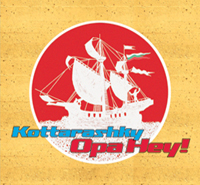
KOTTARASHKY
OPA HEY! (Asphalt Tango CD-ATR 2609)
Some music makes you want to jump up & shake, and then there are contemplative discs where you sit back with your soporific of choice and let the music wash over you. There are times when you are working and want music that is capable of fading into the background but helps keep you focussed on your work. This is not to dismiss this class of music as unlistenable: there are times when you don't want the music to take over, when you are concentrating on something else and music makes the routine less drab. There's a part of your brain that is comforted by a wash of sound, a bit more engaged than say the ocean. I have been playing this CD while I work and it's perfect for being present yet keeping a distance. This I attribute to the fact that it is loop-based. Kottarashky is a young mixologist with a nice grasp of vintage Balkan music. He takes archetypal Gypsy riffs: a violin whine, a skirl on the clarinet, a phrase on an accordion, and throws them into a cauldron with some trance-like drumming. It has the loping quality of Gypsy music but also the North African drone we associate with the Joujouka initiation ceremonies or Gnawa trance music. And, yes, every now and then an old geezer exclaims "Opa, hey!" He's very present for a second but then the music goes back into its rambling anecdotal tale of drab villages animated only by sheep and great floods & the guy who was half-man half-goat, conjured by fragments of half-remembered sound. It's like the end of the tram line in Sofia, where you step off into the mud and in front of you is a dark ancient land that stretches to Turkey, Arabia and India & behind you ... more darkness? You don't remember; you just know you have to keep moving away from it. This CD is an aural journey like no other. The source material is superb but it's the way Kottarashky has woven it together that makes it so unforgettable. (You can sample the music on his myspace page.)
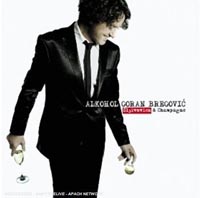
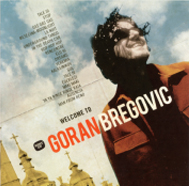
WELCOME TO GORAN BREGOVIC (www.wrasserecords.com)
ALKOHOL
Largely unknown to us, Goran Bregovic rose to stardom as a pop singer in his native Yugoslavia in the mid-60s. His band White Button released a dozen best-selling albums over the next 14 years. Their charismatic leader bridged the cultures as the son of a Serb and a Croat. Taking time off from the pressures of being a rock idol, he was approached by Emil Kusturica to score his film "Time of the Gypsies." Then the two collaborated on "Arizona Dream," which also brought in Goran's hero Iggy Pop to vocalize "In the death car," with a reggae bass. He worked with Ofra Haza, Scott Walker, and Cesaria Evora, then wrote the score to Kusturica's "Underground." 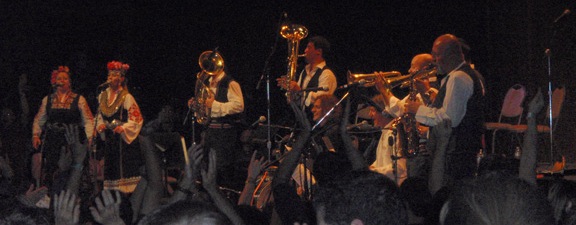
He brought his Weddings & Funerals Orchestra to San Francisco in Spring 2009 to promote his latest album "Alkohol" which showcases his diverse background in pop and classical music. This huge ensemble features a small brass band, a string quintet, a male voice chorus as well as three women singers, Goran himself on electric guitar and a guy who looks like his twin on trap drums. The varied musicians on tap are ideal to allow him to showcase many facets of his talent: from ballads with hovering strings and heavenly choirs to rockers with pumping horns. It's a complete package and indicative of the great wealth of music coming out of the revitalized Balkans.
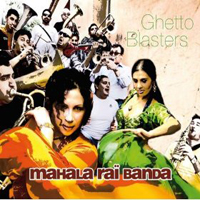
MAHALA RAI BANDA
GHETTO BLASTERS (Asphalt Tango CD ATR 2509)
This is what I am talking about! A raucous gypsy party record. Everyone needs this disc from the Balkan groovemeisters, who have been compared to the Memphis Horns meets Muscle Shoals rhythm section. Even without the disco remixes that propelled them to our consciousness in the incredible ELECTRIC GYPSYLAND series, they smoke. It's been five years since their first album, and the breakout hit "Iest Sexy" (now a global Balkan groove staple), and they have been practicing and improving. In fact they realized they could do the "remix" thing pretty well on their own, so there are great stop and start breaks, and clever tempo changes, etc, like in "Solo para ti," which chugs along with some techno-flamenco touches, like Ojos de Brujo. This is a really well-crafted album with lots of raving and then it cools way down to an organ-driven ballad (with accordion), called "Balada," (you can sample it on the website linked above) but is off again with a full complement of brass, accordion, drums, vocalists, even guitar and cembalom. And believe it or not, this taraf is led by a violinist, but he is not audible for the most part! The brass is over-the-top delirious, the mood is roguish, sweaty, unshaven -- and that's just the ladies! Och, only kidding.
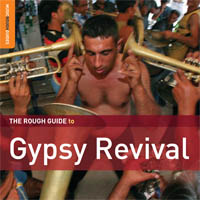
THE ROUGH GUIDE TO GYPSY REVIVAL (RGNET1221)
Gypsy Revival is a great name for this movement because, while it is an ancient as any musical form, Gypsy music has evolved and kept up with the times and is one of the most progressive genres of world music. Sure it is great to check in with the Electrichord reissues but the new stuff coming out -- fusions, remixes, up-&-coming acts -- is very exciting. Rough Guide provides a whirlwind tour of the borders of the style, from Kal to Ojos de Brujo, to the big brass bands like Mahala Rai Banda and Kocani Orkestar. You can't be an outsider in an outsider art form, so everyone gets to have their say. Three of the 13 tracks come from the excellent ELECTRIC GYPSYLAND comps and you certainly have those discs. "Siki Siki, Baba" -- Gaetano Fabri's clubby remix of Kocani Orkestar -- is still one of the outstanding tracks of recent years, & shines here. New to me is Dunkelbunt, a German DJ, who adds dancehall reggae toast over a spacey version of "Asphalt Tango" by Fanfare Ciocarlia. It's definitely in the Electric Gypsy vein. But the disc goes downhill, for me at least. A gypsy sampler is fine but then you yearn for a sustained dose, and here in timely fashion is a whole bonus disc devoted to Shukar Collective. They are a bit more dubby with an incredibly mournful raspy vocalist. This bonus disc puts the first sampler in better perspective, as it shows the roots and direction of the collective. It's not drum n bass so much as drum n beast, as you imagine wild dancing bears on codeine.
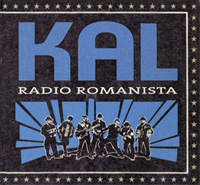
KAL
RADIO ROMANISTA (Asphalt Tango CD ATR2009)
I had this experience that I may have already related to you. I was watching the Taraf de Haidouks DVD and when it ended my television came on. It was tuned to PBS, which is the American Public Broadcasting station, and they were running an old Lawrence Welk show. (PBS schizophrenically tries to find an audience, so they run really creaking stuff like Welk but then they throw up Eric Burdon or Jim Morrison to try to snag a younger audience -- which is actually the up-&-coming geriatric crowd.) Anyway, there was Myron Florin playing his accordion, and other beloved characters, and I cannot tell you what I thought because it is potentially libelous. Welk and his 20-piece band played polkas and other Eastern European music that had remained popular in the USA but it was so devoid of life, so reduced to cartoon formulae, that it was just bland musical earwash. When you hear real gypsy music, like this new KAL CD, you realize how it is a living evolving entity, and so slippery you can barely grasp it. This is Rock 'n' Roma: punk energy suffused with the spirit of dispossession. Though are punks more socially alienated than gypsies? So it's doubly disconnected from the mainstream. There is great guitar (lead singer and guitarist Dragan Ristic), violin (Vladan Petrovic is outstanding) and two accordions, but also a clarinet shows up as well as other guests. I guess the Clash are an influence, not just from the title: You can hear it in the vocals, some of the tempi, and Goran Savic's drumming. It's been three years since Kal's debut CD, which featured lots of guest vocalists, and they went from being an obscure Belgrade bar band to touring ceaselessly, playing festivals in Europe and the USA, but it paid off because now their sound reflects three years of pushing themselves to explore and excel. This CD represents their live sound and their diverse and highly original repertoire.
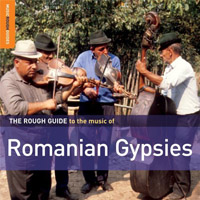
ROUGH GUIDE TO THE MUSIC OF THE ROMANIAN GYPSIES (RGNET1210)
From Taraf de Haidouks to Fanfare Ciocarlia to Toni Iordache this disc lopes along with panache and ebulliance. Gypsy music is very enjoyable, even when it's down in the dumps, and the artists assembled here are the cream of the crop. New to me is clarinetist Mielu Bibescu who shows that even if you are unknown outside your homeland, many Romanians have world talent. Check out the State-owned Electrecord label for crazy covers. We delve into their vaults for violinist Ion Petre Stoican and then we rock out with Mahala Rai Band and the remix of their romping "Iest sexy." Shukar Collective's "Taraf" is a techno refiguring of a traditional form known as "Usari" music. It works. Smash hit "O Carolina" pops in for a second to introduce the great "Kan Marau la" by Fanfare Ciocarlia from the Kings and Queens disc. The second half of the disc explores some less-well-known artists, including Floria Ceoaca, and Cornelia Catanga (licensed from the state record label). Like I say there are lots of relatively unknown musicians from Romania with huge talent. The eerie Dona Dimitru Siminca shows up, but programmer Dan Rosenberg has pried a gem rather than just grab track 1 from the recent disc, as many compilers are wont to do. We wend our way to France with Ion Miu, the "Mozart of the Cembalom," for a really nice closing number. This compilation is a careful labour of love and it will warm the cockles of your presumably salty heart.
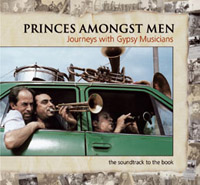
PRINCES AMONGST MEN [Asphalt Tango CD TR1608)
Garth Cartwright is a Kiwi with a passion for the music of the Balkans. "Bal" is Turkish for blood, and "kan" is Turkish for honey, he explains, describing his fascination for this contradictory and vibrant culture. In 2003 he set off to explore the simultaneously demonised and romanticised world of gypsy music. He wrote a book PRINCES AMONGST MEN and then asked Asphalt Tango to come up with a soundtrack album. This is the result, and it's a gem. Cartwright writes, "Rakija, cigarettes, fried meat, pickled vegetables, beautiful girls, absolute chaos and music of unearthly beauty ... these were constants on my Balkan travels." There are a few familiar tracks on this compilation, as is inevitable with any hits anthology, but there's enough good new stuff and surprises to make it worthwhile. "Oh Carolina!" the Mento classic will go down in history as one of the important crossover songs. Not because the Jamaicans got it from Trinidad, but because it made it halfway round the world to Romania where it mutated into "Kan marau la," one of the outstanding tracks on this compilation of nothing but gold. It was also the lead track on Asphalt Tango's 2007 compilation QUEENS & KINGS, which deservedly won all the world music awards last year. QUEENS & KINGS was a live recording centred around Fanfare Ciocarlia. They energized a fiery set of guest artists and you get the same feeling from this anthology. There are two vintage cuts, selected from the exceptional Songs from a Bygone Age series, one each from Toni Iordache and Romica Puceanu, to ground this, but there's the equally solid piece from Esma Redzepova which has not been released previously. Great works from Taraf de Haidouks, KAL and Johny Iliev may be familiar but they are surrounded by wonders from Ferus Mustafov, gypsy legend Saban Bajramovic, Sudahan and a host of others you probably haven't heard of. The Golden trumpet of Boban Markovic is here, of course, doing "Disko Dzumbus," and so is the great Kocani Orkestar, but we also get to hear Rom Bengale doing a previously unreleased cut called "Disko Gitane." In another contradiction the music is both martial and lyrical at the same time. This disc sparkles and crackles with electricity from one end to the other!
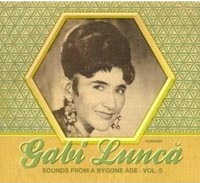
GABI LUNCA
SOUNDS FROM A BYGONE AGE VOL 5 (Asphalt Tango ATR CD058)
At its best, music takes us out of ourselves or triggers forgotten memories. I was listening to and enjoying the latest release from Asphalt Tango, one of my favourite labels, because they are so eclectic, diverse and always on the money, when I heard an accordion that sounded like a harmonica, and I remembered Larry Adler playing "Geneviève" which was the soundtrack to a 1950s film about the London to Brighton car race. It was a weird moment because I remembered the cinema (loose chairs in a big hall, with the projector at the back on a trolley and cables along the floor to the speakers) but it was so totally unexpected. I mean gypsy music seems like the last thing to take me back to my childhood. I looked up the film on IMdB and I was 3 when it came out, perhaps 4 when I saw it. Come to think of it, "Gypsy" was the first "world" music in many homes. Lots of folks with hip parents (the ones with beards and pipes that wore turtlenecks and sandals with socks -- no, not you Jeff) had a few old gypsy albums on the shelf between Mantovani and the Norman Luboff Choir or was it the Swingle Singers? In America the really crappy ersatz gypsy music of bubblemeister Lawrence Welk played big well into the 70s. But here is the real deal. Asphalt Tango has dug into the archives to finds music from the time when the Berlin Wall separated Western Europe from the Soviet countries, among them Romania where Bucharest was known as the "Paris of the East." Only a few artists were allowed to record and, in the case of popular singer Gabi Lunca, her music was only played on the radio at 5 a.m., so her fans would wake up early, make a glass of Nescafé and get ready for the day. She was married to a virtuoso gypsy accordion-player, Ion Onoriu, and they appeared on radio and TV frequently, as well as numerous café dates until the Ceausescu regime clamped down on her too-perceptive lyrics. Among the legendary Lautari musicians who would get together to record on the state-owned Electrecord label were tzimbalist Tony Iordache (subject of the previous issue, volume 4) & trumpeter Costel Vasilescu. Thanks to Asphalt Tango, these names are now returning to deserved prominence in the field of gypsy music. Their virtuosity is so apparent it transcends time and musical barriers. Rob Walsh brought up an interesting point in his weekly post, how he sometimes prefers vocals that are not in English. I agree, first you are not distracted by listening to the lyric, and secondly it makes the voice more of an instrument in the mix. I was listening to Ella Fitzgerald scat singing with trumpeter Roy Eldredge and thinking how she freed the human voice to be one of the horns. Gabi Lunca's voice can take you there, instrumentally (though of course if you understand Romanian it has a lot to tell you). The last survivor of her generation (now 70), she is retired but you can hear her, alive and kicking on
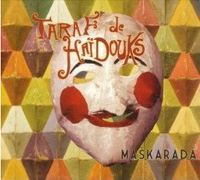
TARAF DE HAIDOUKS
MASKARADA (Crammed Disc CRAW40)
Holy moley! How can these guys continue to get better? They are already sensationally good at what they do: traditional Romanian gypsy music, and can throw it down with the best of them. Now they have upped the ante and topped themselves (I don't mean committed suicide, far from it) ... This is a great concept for an album, perfectly executed. OK, I am so excited I have to slow down to explain this. You know how in the nineteenth century Beethoven and Schubert would hang out in the tavern and listen to folk music then run home and take the melodies and add a diminished seventh and a flatted fifth & a few bosso chords and call it great music? That artistic license continued, so by the turn of the twentieth century it seemed okay for Prokofiev, Mussorgsky and then Bartok and Berg to "adapt" folk sources for their music. And who did they hit the hardest? The underpaid, despised black folks of Europe, the Hungarian gypsies. So now it's payback time, the wild and witty band of gypsies from Clejani have torn up the sheet music and go for the guts of Bartok, Khachaturian, Manuel de Falla & Isaac Albéniz. The result is stunning. This is brilliant. The two most famous pieces, Albéniz' "Asturias" and "In a Persian Market," light classics from the pre-film era, are little mental movies, trips to Andalucia (where you don't have to queue all morning to see the Alhambra!) or Baghdad where there are fountains & princesses in disguise drawing water with the servant girls.
We kick off with a "Romanian dance" of Bartok from "Mikrokosmos" (1940) -- it's effortless, held together by Ionica on cymbalum. The clarinets handle the tempo shifts as if they were hiccups, the violins likewise toss it off without a second thought. Instead of "Sabre dance," they throw "Lezghinka" at us (from the same Khachaturian ballet "Gayaneh") & rip it up fiercely.
You know the De Falla piece (from "El amor brujo" of 1915), but it never had this kind of manic vamp, even after 100 heroines had been tied to 100 railroad tracks. The accordions stir as if a flea is getting to them then the great Viorel Vlad on double bass lays down the law. The chase is on to a flaming outro. Back to Khachaturian, and his famous waltz from"Masquerade." Come on, you know it, you surely know it. There you are, singing along. For me the centre-piece is Albert Ketelbey's "In a Persian market, " (1920) which was so popular, it was even covered by Tommy McCook. Where's my fez? The violins have a nice quarter tone dissonance making them a bit like Portsmouth Sinfonia at times, but also it brings you right back to the pit orchestra of the music hall, where much of this music was transmitted to our grandparents and great-grandparents' ears. I know it well because I had musical grandparents who played this music well into the 1950s. I don't mind admitting I have the sheet music & play it myself! For the Taraf the centre-piece is probably the suite of Romanian folk dances by Bartok, the longest track on the album. Needless to say they take it all back. "Asturias" is a stormer, they rip into it, then sit back for the largo part. I am wondering if they transposed it to C, I have such a hard time with Albéniz keys! Nah, it would still be tough. But wait what are they doing here? They go off into their own thing at the end. "Les portes de la nuit" by Kosma (one I don't know, it comes from a Marcel Carne soundtrack) includes "Autumn Leaves" and it's quite symphonic, but with a vengeance! The accordions float in and out in the mist but the cymbalom keeps creeping up on you (Look out!). As if all that were not enough there are 7 original compositions to remind us of the creative power of this band. It's a great selection, exquisitely performed and crisply recorded.
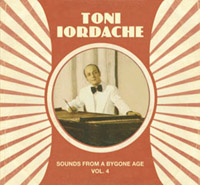
TONI IORDACHE
SONGS FROM A BYGONE AGE VOL 4 (Asphalt Tango CD ATR1307)
My favourite gypsy instrument is the cimbalom (tzambal, tzimbel, cymbalum, tzimbalom, zimbalom, dulcimer) or piano guts hit with a pair of hammers. Iordache was a much in-demand session man who fronts this session that features accordions, violin, double bass, and also trumpet, played by the great Costel Vasilescu who popped in on the Gore brothers session earlier in this series, and, with Iordache, on the fabulous ION PETRE STOICAN recordings that constituted volume 1. I love this series because the sound is crisp and the packaging is elegant, in contrast to the hokey gypsy LPs I remember as the first world music that was generally available in my youth. Iordache was such a huge hit in the 1970s he was allowed to leave Romania as a socialist ambassador to play abroad. When he came home he usually had to go straight to a gig where his band were waiting; when he practiced at home he had a stack of reel-to-reel recorders running to generate live tapes for sale to collectors. But he was convicted of smuggling foreign currency and was jailed for 3 years, even though he was considered as important to the country as the head of state Ceausescu and the world-renowned tennis champion Ilie Nastase. Something about the loping gait of the music, as the cimbalom tinkles along like a knackered cartoon mechanism, & the accordion fusses about in the background, really appeals to me. When Iordache was 12 years old, other musicians were scared of the skinny kid. If you want to know why, start with track 7: "Ca la breaza" (You can sample it on the Asphalt Tango website), & hear his blinding 25-beats-per-second brilliance. Iordache died of diabetes in 1988, age 46.

GYPSY CARAVAN
MUSIC FROM THE FILM WHEN THE ROAD BENDS (World Village 468070)
No doubt you've seen Tony Gatlif's great documentary LATCHO DROM. That film completely opened our eyes to the currents of music that wend from Rajasthan to Poland, and from Egypt to Spain. Through it we discovered Taraf de Haidouks and Hameed Khan's ensemble MUSAFIR. Then we got to see them on tour and suddenly a gypsy revival was in full swing. Today these groups tour regularly, make films, win awards and hang out with Johnny Depp and other show biz types. The latest wrinkle in the gypsy trail is a return to that bright moment captured by Gatlif: Jasmine Dellal, another documentarian (who worked with Marlon Riggs), has made her version of the gypsy tale (which I have not seen yet) and this is the soundtrack album, which bodes well for the enterprise, the film, and no doubt more tours.
Gypsies, as is well know, spend their lives on the road. The gypsy caravan used to be a very romantic notion and the lore of gypsies has engaged non-Roma since George Borrow, Cervantes, and even earlier writers. The title of the film was going to be YOU CANNOT WALK STRAIGHT WHEN THE ROAD BENDS... (a Romani proverb), but marketing forces got involved and it became GYPSY CARAVAN, which is a lot less inspired. Let's hope the marketers didn't insist on anything else. Actually the first title reminds me of one of my favourite maxims, from Yogi Berra: "When you come to the fork in the road, take it!" Right from track two, when Fanfare Ciocarlia start playing live, you know this is going to be exceptionally good. Esma Redzepova, with her clear voice, delivers "Romano horo" (apparently footage of her from 40 years ago when she was a teenager) and then after a bit of table percussion, bottle tapping, etc, and some spontaneity on accordion, we get into Taraf de Haidouks with Filip Simionov adding clarinet, doing "Carolina," now thoroughly Romanized, though of course it actually started out as the well-known Caribbean folksong, "O Carolina!" The film-maker explains she had over 50 hours of music on tape and it was an embarrassment of riches, so the film is just the bits that worked best, though there were uncaptured moments on tour -- in airports, customs detention rooms, hotel rooms after hours -- that were even more compelling, if you were there. The group called Maharajah from Rajasthan is actually a blend of the two well-known groups the Langa and the Manganyar (all are Muslim, and have the surname Khan). I recognize "Roomal" from their repertoire, but there is also an interesting dubby club mix of one of their tunes. I can't wait to see them playing at home in the Thar desert. There's an extended set of them on the CD then we get back to Esma Red Zep, now with Fanfare Ciocarlia (from the KINGS & QUEENS album) tearing through "Nakalavishe," and Taraf de Hijkinks doing their "slow" about the "Little Blossom," "Mugur Mugurel." The film was shot by legendary cinematographer Albert Maysles. For showtimes near you check the film website.
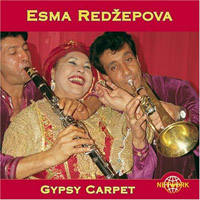
ESMA REDZEPOVA
GYPSY CARPET (Network 495116)
From Network Medien in Germany comes the Return of the Gypsy Queen & her Ensemble Teodosievski. She is, perhaps, the Celia Cruz of Macedonia. Esma comes from Skopje, and has been recording for over 40 years, with a husky voice. She was discovered as a teenager by Stevo Teodosievski who later became her husband. She and Stevo couldn't have children so they adopted 47 street kids and started a music school. Now grown, some of those sons are in her band. She has won many awards and been given a diplomatic passport as she is constantly touring and performing. She is even "Queen of the Gypsies" in Rajasthan. After the break-up of Yugoslavia she returned home and one of the two TV stations in Skopje was in her basement for a while! This is classic gypsy music from a vast repertoire, some of the tunes adapted from brass bands. Zahir Ramadamov on clarinet and Bilhan Macev on trumpet are noteworthy.
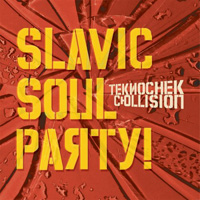
SLAVIC SOUL PARTY
TEKNOCHEK COLLISION (Barbes Records BR0015)
This is a well-crafted and all-round superb album that unites various strains of Balkan and gypsy music. The label is based in Brooklyn and I think the band are second-generation Eastern European Jews, Gypsies, & who knows who, living in New York (with a Japanese drummer) who are exploring their musical roots. This is their third album. There are little sound collage snippets of live performance, old people reminiscing etc ("That's the shtreet i used to live on, but i can't remember vere..."), that add to the atmosphere. (I did listen to the BORAT soundtrack which had some excellent gypsy music on it, but I expect the samples of "wit" from the film will wear thin.) At the outset the leader, Matty Moran, I suspect, does a gravelly introduction (you can picture him twirling his Uncle Joe Stalin moustache as he does it!). Then we get some kicking brass fierceness. These guys are on the case. I have a passion for good brass band music and even though they bring in accordion, it's mostly a wall of brass with good contrapuntal arrangements. To sweeten the deal they throw in two traditional gypsy songs sung by Eva Primack that nicely break up the instrumental tracks. Her "Djelem, Djelem" is a fine take on this song that has become the gypsy anthem. Yes, I hear "Frere Jacques" quoted and, smack dab in the middle, there's a number by Toussaint, which must be Allen as it has a definite Crescent City vibe to it. Mostly it's big brass, one reed player (sax or clarinet) & a drummer (snare or darabouka). They pour on the funk for "Never gonna let you go," which is the last track listed on the sleeve: a stand-out, this one deserves massive airplay (I think that's a truba solo on there!). After another bit of ambient chatter they do a fiery dub remix with deconstructed accordion. Buy this one, it's a keeper.

BALKAN BEAT BOX
NU MED (JDub106)
In contrast to the well crafted Slavic Soul Party release, this Balkan Beat Box offering is over the top. They are just trying too hard. First they have more guests than original members on the session (including two horn men from Slavic Soul Party), making you wonder just how good they are on their own. Then they manage to get everything but the kitchen sink in here: too many samples, too much horrible rapping. They pride themselves on including musical influences from all over the mediterranean, but you don't really need to hear all of them simultaneously in every song. Apparently their live show is something of a circus act and you get that vertiginous swanee-whistle craziness running through this disc. Yes, levity and humour are one response to tragedy but this band is not going to march around Israel and make the walls come tumbling down. A noble idea: good lucking putting it into practice. So there are moments of musical sophistication, enough to make me want to like it, but it's hard to hear the good parts when they are constantly interrupted by mad rappers and gratuitous overdubbed effects. This is too frantic to enjoy.
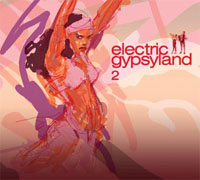
ELECTRIC GYPSYLAND 2 (Crammed Disc Craw37P)
Sequels usually sop up the dribbles from a great album, but here is a sequel that's every bit as good as the great first album. ELECTRIC GYPSYLAND 2 is a collection of remixes of three of the top Balkan Gypsy bands (Taraf de Haïdouks, Koçani Orkestar and Mahala Raï Banda). Gaetano Fabri & Shantel are the only mixologists to return from the first disc which was my top album of 2004 with its endless surprises and great variety of styles. Balkan Beat Box, Oi Va Voi, & Smadj show up with some recruits from the Balkan club scene (DJ ClicK, Forty Thieves Orkestar, Russ Jones, Russendisko), and there are wilder contributions such as 43 Skidoo featuring Susheela Raman, or Buscemi, best known for reworking Brasilian beats, and ShrineSynchroSystem. Many additional guest musicians (from Europe, Turkey, Africa), add overdubs to extend the sound and re-imagine the gypsy riffs for the club milieu.
In addition there's a bonus disc that is the best gypsy sampler I have heard to date. In fact it's great to have the raw material these remixes were made from because they are occasionally far-out, and the original tracks by Taraf de Haïdouks, Koçani Orkestar, Mahala Raï Banda & (new to me) Zelwer cleanse your ears and prepare you for further immersion in the electric antics.
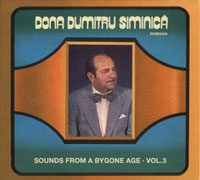
DONA DUMITRU SIMINICA
SOUNDS FROM A BYGONE AGE VOL 3 ( Asphalt Tango ATR1106)
The third volume of this handsomely packaged Gypsy reissue series comes from Romania. At first I didn't equate the dapper bald chap on the cover with the singer's high-pitched female voice, imagining a portly matron with her hands clasped under her bosom primly facing a microphone. But now I realize the voice is emanating from this geezer and the melismatic sad suburban ballads he sang were all the rage in cafe society in in Bucharest in the cold Communist era. The whole album is tinged with sadness and longing. There is a sustained plinkety cymbalom, sporty accordion fills and a stately bass thomp, but mainly you are here for the high androgynous falsetto voice shivering up and down the bluesy ballads. You can't imagine this voice doing up-tempo numbers so here you are awash in pathetic consolation for the lonely and warnings that prepare the newly-infatuated with the inevitable doom of their love. Siminica grew up next door to the Gore brothers (see volume 2) so was immersed in the gypsy musical tradition from an early age; his father was also a violinist. Siminica learned violin but it was his voice that drew fans to him and soon he was part of the team of artists visiting Electrecord, the state recording studio, along with his pal accordion-player Costica Serban. Sometimes they would show up at the studio without a band and pop into the nearest bar and ask for a bass player. After the session they'd be back in the bar celebrating and drinking up their wages. Because of his popularity, Siminica was one of only two artists able to record songs in the gypsy language. Despite his massive popularity in the 60s, when he died in the 80s there was no notice in the Romanian press and though little is now known about him, this record is a testament to his greatness.
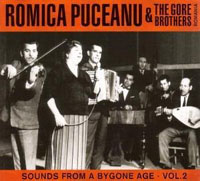
ROMICA PUCEANU & THE GORE BROTHERS
SOUNDS FROM A BYGOME AGE VOL 2 (CD Asphalt Tango ATR 1006)
Volume One in this new series, by Ion Petre Stoican, was a real revelation. This second disc has also been restored to excellent sound quality and contains some fine work by the queen of the gypsies ("the Billie Holiday of the East") & her band comprising Victor Gore on accordion and Aurel Gore on violin. (Their name was Ionescu and their father was a famous gypsy musician also; they adopted his first name on his death.) The music of the gypsies (or Lautari) was largely underground until 1964 when they began to settle on the edges of towns in Romania and spontaneous groups called Tarafs would assemble to entertain in cafes. A typical taraf consists of a singer, violin, double bass, cymbalom, accordion and cobza. (The latter a near-forgotten lute, with a backward curving fretboard and strings in the upside-down order [à la Hendrix], played by plucking them with a quill.) Though they never got rich, the Gore brothers were the supreme exponents of gypsy music in Bucharest and recorded frequently for the Electrecord folklore archive. They also played exclusive restaurants with Victor singing until they heard Romica Puceanu, who had started out in 1940 age 14 as a professional singer. She was quite polished with a vast repertoire and could also improvise which suited the brothers perfectly. They recalled her humour: she would show up at a recording session with her teapot, which was filled with cognac. Once the recording engineer noticed she was holding the song lyrics upside down, and she replied "Would I be singing with these guys if I could read?" Traditional gypsy music from that era tends to be lush and overly self-indulgent, the weeping-in-your-drink type, but these recordings are quite understated, almost minimalist, so you have to pay attention to hear the plink of the cymbalom and the little ripples of the accordion. But the space surrounds the vocal instead of swamping it in schmaltz. Costel Vasilescu also contributes trumpet to five numbers on this compilation. The music was eclipsed by Balkan pop in the 70s but these reissues should help bring it to a wider audience.
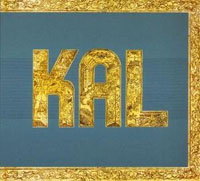
KAL (CD Asphalt Tango ATR 0906)
Gypsy music has evolved rapidly in the last 30 years. It was shoved aside by Balkan pop and then all music was buried by the civil war, though we might have sensed impending martial doom in Laibach. In the Tito era I hitch-hiked through Yugoslavia. People were curious about me, a Western kid with shoulder-length hair. They wanted to buy my jeans, which I did sell when I was broke. They would invariably ask me if I liked Tito and Johnson. I told them Tito was good, LBJ bad. That always got me a shot of slivovitz. Tito held all these disparate cultures together with his iron gloves, even finding a place for the Roma. Yugoslavia was a lot less grim than Bulgaria where everyone was dying to escape. But then it all fell apart along good old ethnic lines. "Marx wasn't a German, he was a Jew!" says the Orson Welles character in the Stranger, and from this the detective (Edward G. Robinson) knows he's a Nazi. KAL takes the opposite approach and includes everyone and every style in their music which is what makes it so engaging. They are from the suburbs of Belgrade and play gypsy music that casts a wide net, gathering in Turkish, Arabic and Western (rock) influences. Kal is the Romany word for "Black" as the band's founders, Dushan and Dragan Ristic, chose it to confront the prejudice that gypsies constantly face. They also felt gypsy music faced a musical blight with electric gypsies turning up at weddings with a synthesizer to replace the band. Post-Tito music was swamped by what Dragan calls "turbo trash" where the lowest common denominator was allowed to rule (like in American pop). Though this album was produced on a tiny budget, it's a fine production with great studio engineering by Mike Nielsen. There are touches of bhangra and rap (a funny drawling take from satirist Rambo Amadeus, but without translation). There's even Hawaiian slide guitar on the amusing "Gurbetski Tango" which features tuba laying down the bass. Using traditional instruments KAL has found a place for gypsy music in the 21st century.

TARAF DE HAÏDOUKS
THE CONTINUING ADVENTURES OF... (Crammed Disc DVD TDH2)
The latest offering from the Romanian Band of Brigands continues with more gypsy hijinks at a breakneck pace (Even the slow numbers have hidden rapids). The music is much the same as on their earlier albums but this time there's also a DVD if you need to take it laying down. The DVD is interesting as it includes concert footage (the same set you hear on the CD) directed by Marc Allen, interviews, and a history of the band cobbled together from their own home movies. Tony Gatliff's daughter, Elsa Dahmani, made an hour-long documentary about them, "No man is a prophet in his own land," in 2001, and that's part of the package also. Featured is the Taraf's memorable jam session with the Koçani Orkestar and a Bulgarian clarinetist, Filip Simeonov, and other bright moments from their BAND OF GYPSIES recording.
During the set, recorded in the atmospheric old Union Chapel in London, there's the deconstruction number "Back to Clejani" where the violinist pulls on a horsehair attached to his string which sounds like he is tearing apart the sound. Falcaru (who reminds me of a Pasolini character) plays a storming pennywhistle solo on "Little Buds." "A stork crosses the Danube in the company of a raven," is the longest number and there's a chance for everyone (except for Viorel, the great double bass player) to solo, my favourite being the cembalom player Cristinel Turturica. There's a very inspired breakdown in the encore, "Briu opsa," where they all start making animal and bird sounds on their instruments before rejoining one last speedy chorus. Sure it's shtick but here it works well.
Their French manager tells how this Robin Hood outfit busk after shows (I've seen them do this twice in UC Berkeley's Lower Sproul Plaza) in order to milk more money out of the patrons. (If they have $25 for a ticket, they've certainly got a few more bills in their wallets!) He also says they used to sell empty cassettes to the crowd telling them they were concert tapes, but he had to point out to them that if they were successful they would probably be coming back to the venue and didn't want to alienate the audience. Three of the songs are recorded here for the first time. It's essential listening (& viewing) for gypsy music fans and, if you haven't hooked up with the Haïdouks yet, here's a great place to start.
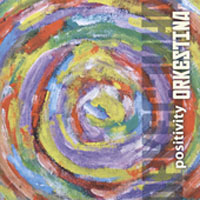
ORKESTINA
POSITIVITY (World Village 498009)
A lively collection of Balkan gypsy music, with klezmer and traditional Eastern European musics thrown in, this is the fourth album from Orkestina, a superb quintet with a full sound, based in Barcelona. After a moody intro on "Radole," a communist hymn that gets quite Turkish, we see them switch to guitar and clarinet for a Romanian gypsy dance, then accordion and violin join the fray. Double bassist Manolo Lopez is outstanding here. "Derte magare" sees the clarinet of Litcho Hadjikianov step to the fore. At first he is accompanied by tambura, then two minutes in the accordion and violin start a groundswell under him. It's very atmospheric, as is "Zasto li goro (the leaves are falling)," a lament about Bulgarian partisans trying to defend their land from the Ottoman army. This one sounds Celtic. I could imagine the violin part fitting right into an Irish lament. The fiddler is named Colum Pettit so I could be on the right track. There are up-tempo pieces on here too ("Not suitable for people with a heart condition"), but it is the slow numbers that get to me. They have sonorous bowed bass and swelling subcutaneous currents that finally break out into a sweat. The "Zelona Dunova suite" dedicated to the Danube (which is green, not blue) comes on with a familiar air and a guest, Aksana Nairanouskaya on hammered dulcimer (what's left of your piano after the Ottomans get through with it!). (Okay, I take it back, and won't use that joke again.) For a complete change we go to the New World for the klezmer rant "Second Avenue square dance," described as Yiddish swing. The session ends with "Shopsko Horo," a typical Bulgarian dance featuring Ivan Dimitrov on gadulka, that has become the group's signature piece.
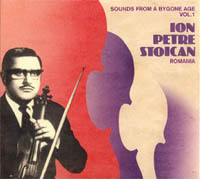
ION PETRE STOICAN
ROMANIA (SONGS FROM A BYGONE AGE VOL 1) (Asphalt Tango Records ATR 0805)
I try not to judge music by the cover but this looked suspiciously like one for the mouldy fig club: I mean how could a dusted-off disc of traditional Romanian music have anything like the fire of contemporary gypsy groups? Well, I was wrong, once again. This is a stonking set: it stomps, rocks and rules, and sadly (now that I contemplate it) the only time these musicians recorded together. Because it was the Ceausescu era (1977) the group were only identified as "People's Orchestra" but the line-up is the crème de la crème of the Lautari. Typically an artist would be the main soloist in order to stand out on their recording and not hire a whole array of top notch players to vie for solos, but this is not a typical recording. Stoican was working the wedding circuit in Bucharest in the 60s and saw a man acting strange. He told the police the man was trying to hide something and the police arrested him. Turned out he was a spy with a large bag of cash and the Secret Police had been after him for a long time. They offered Stoican a house as a reward. I don't need a house, he said, I want to make a record! It was a few years before he was able to push the state-owned record label Electrecord to fulfill the deal. With the help of trumpeter Costel Vasilescu they assembled many top musicians to rehearse. Tony Iordache on cymbalom went along because he really didn't believe this hick violinist had the power to get the state record company to do what he wanted! His condition was his name would appear on the album cover! In the end fourteen musicians played on the recording, much more than the normal Taraf line-up of five. They doubled up so there are two clarinets, two accordions, two double basses, and six violins. Most of the material consists of fast numbers typically played at weddings. Half of the tracks are "Hora" which is a circle dance from Constanta, including "Hora Lautareasca," a repertoire standard where you can compare these old-timers to the current crop (the clarinetists are particularly sprightly and inventive). I also recognise the tune titled "Ia-ti mireasa, ziua buna" on which Stoican sings in a quavery falsetto and the muted trumpet of Vasilecu and plinkety cymbalom of Iordache stand out. Things go flying out the door with the couples dance "Sirba" which ends the sesson. Even if you are a fan of traditional gypsy music you probably don't have this in your collection and, as it is one of the foundation stones, you need it.
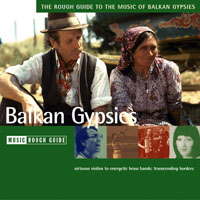
THE ROUGH GUIDE TO BALKAN GYPSIES (RGNET 1159CD)
The last few years have seen a rebirth of gypsy music with some great bands like Mahala Raï Banda, Taraf de Haïdouks, Boban Markovic Orkestar, Fanfare Ciocarlia and Shukar Collective joining the ranks of greats like Ivo Papasov & Omar Faruk Tekbilek. Their emergence has seen Crammed Disc, the Belgian label behind several of these bands (Mahala Raï Banda, Taraf de Haïdouks and Fanfare Ciocarlia) as well as Konono #1, propelled to the top of the world music charts in Europe. The good news is all of these artists I just mentioned are on this Rough Guide, so if you don't have their discs, you'd better get started here. The only significant omission that I can see is Kocani Orkestar of King Naat Veliov, the gypsy brass band from Macedonia, but there's brass aplenty to sample. Like the Langa & Khan families in Rajasthan, Balkan gypsies show up at weddings and other festivities and guarantee a good time for the guests. While their economy is in no better shape now that we are for the moment past dictatorships in the region, the long heritage of "Balkanisation" has meant that ethnic minorities like gypsies have been regularly scape-goated in times of economic duress and are still marginalized in society. Though I prefer whole albums by an artist to compilations, this collection has some gems that will send you back to the artists' repertoire. Fanfare Ciocarlia's "Lume lume" is a musical masterpiece. There's a sustained horn vamp and an unearthly ladies chorus intoning liturgically over the top, with those wobbly trills you recognize from the Bulgarian Ladies Choir all those years ago. New to me is Esna Redzepova, crowned "Queen of the Gypsies" by no less than Indira Ghandi in 1976 when she won first place at the First World Festival of Romany Song in India. Esma began singing publicly as a child and now has been at it for 40 years, recording 600 songs and raising 47 children (not all her own)! She has a high hoarse voice and a polished ensemble with accordion, trumpet, darbuka, clarinet, thumping bass and percussion. After a trip to Greece we get Italian gypsies in the shape of Taraf de Metropulitana. This group came together when gypsies who were busking in the Rome subway started running into one another and soon were a loose conglomeration of underground talents. This is a great track and appropriately has a big echo on it, like they were actually recorded in one of those long tiled subterranean hallways. There's cimbalom and accordion prominently, as well as clarinets and fiddles sawing away madly on the track "Espresso" from their album NEXT STOP COLOSSEO! The Shukar Collective cut is kinda irritating; I much preferred the one Charlie Gillett picked on his Wrasse compilation. Suffice it to say I won't be rushing out to get their album. Fortunately things return to familiar territory with the fiddle of Ibro Lolov from the aptly titled GYPSY MUSIC CD. Ibro is a top accordionist from Sofia, and a must-have at your Bulgarian wedding. He plays a cocek with a hard rapping drum tempo which grew out of nineteenth-century Ottoman military music into a freeform jam.
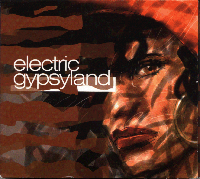
ELECTRIC GYPSYLAND
(Crammed Disc in Europe; Six Degrees in US 657036 1098-2)
I heard this when deejay IJ was spinning and he was surprised at my enthusiasm. It's Balkan gypsy music remixed by clubbers for the global dancefloor. But hey, whatever works! Taraf de Haïdouks already sampled a classic reggae tune "Oh Carolina" and here it is further deconstructed by Bukovina Club of Frankfurt. Dorset DJs Lightning Head have obviously been digging the CHAMPETA CRIOLLO releases because they sample some highlife guitar in their reworking of Koçani Orkestar's "L'Orient est rouge." Señor Coconut takes a completely different tack and gives us a cumbia beat with a weirdly wobbly slice of Koçani Orkestar in his "Altiplano mix" of "Usti, Usti Baba." Back in Dorset (?!), Bigga Bush fires up some heavy manners reminiscent of African Head Charge for his take on Koçani Orkestar, this one called "L'Orient est roots." Things are really smoking by the time Modern Quartet of Novi Sad take on Koçani Orkestar for "Fantasia for Clarinet." I believe the original Koçani piece used here is called "Alone at my wedding." Turkish producer Mercan Dede also tries his hand at deconstructing Koçani Orkestar on the spacey "Siki, Siki Baba." He also introduces new players to carry out his ideas. Olaf Hund rounds things out with cembalo speed and a simultaneous mix of half a dozen tracks called "Are you gypsified?" Then there are the "bonus" tracks... This was a great idea for a CD and makes a wild and wonderful compilation.
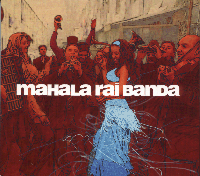
MAHALA RAI BANDA
MAHALA RAI BANDA (Crammed Disc CRAW31)
Hot on the heels of the top release of 2004, ELECTRIC GYPSYLAND, comes this fabulous CD by one of the groups on there: Mahala Rai Banda, from the gypsy ghetto of Bucharest. Aurel Ionita is the leader, singing and playing violin. There's clarinet, sax, two trumpets and tuba, accordion, a taraban (one of those hand-held drums made of ceramic), and drums (the bomp suggests a big bass strapped to the chest, armywise). In addition there's the wonderful spooky sound of the large cymbalum (a piano strained through a basketball hoop), electric and double bass, and a bass taraban (played by the group's producer Stephane Karo who has his magic fingers all over Taraf, Kocani Orkestar and a host of other great bands). Mahala (an indian word) means a place where gypsies live, Rai means noble in arabic, so you have the noble band of the ghetto or village. Some of the band members are related to the Taraf de Haidouks, arguably the best gypsy band in the world, another component of the group comes from the Moldavian army. They enlisted at 14 and being dark skinned were consigned to the army band. The nephews of Taraf's founder Neascu, who have lived in the outskirts of Bucharest since youth, avoiding the pitfalls of drugs and gangs, heard the ex-soldiers playing at a restaurant and teamed up to form Mahala Rai Banda. It's a perfect blend: the martial pomp and solidity of the brass section with the more emotional flights of gypsy melodies, accordion and singing. It's a breakneck album and very addicting: from the Clejani hammered strings of traditional gypsy tunes to wild swinging disco beat of "Lest sexy" there's a lot to engage you. If you loved ELECTRIC GYPSYLAND this is a less-mixed but equally engaging slice of modernized gypsy music.
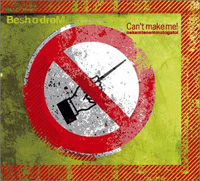
BESH O DROM
CAN'T MAKE ME (Asphalt Tango ATR 0203)
This continues in the same pell-mell mode of breakneck tempos and wild-solos-on-the-brink as my other Balkan favourites, Boban Markovic, Fanfare Ciocarlia & Nat Veliov. The difference is in broader instrumentation and a range of melodies drawn from Afghanistan, Greece, Romania, Egypt, Lebanon, and beyond. Founded in 1999 in Hungary, Besh o Drom's music is Eastern European folk to dance to as well as contemplate. Their versatility and huge fund of inspirational sources gives this a really broad range which makes it a pleasure. A track called "Afghan" is pure jazz with the lead alto sax doubled by a tenor, and the pianist shadowed by a cimbalom which is one of those instruments that looks like the guts of a piano played with drumsticks. This is followed by a track of hard rock derivation called "Yell." Then what sounds like more predictable Romany gypsy music with some circus-like touches, goofy scat vocals and whistles. In short this is a very diverse set, undoubtedly great to see first hand. Their name means "Go your own way" and they have gone in several directions at once. The basic sound is Hungarian, particularly when the cimbalom is lead instrument, but then the ney and derbuka come in and we are lost in the kasbah.
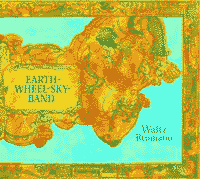
EARTH-WHEEL-SKY BAND
WALTZ RROMANO (Asphalt Tango Records 0303)
This one really grows on you. At first I couldn't figure out how to deal with it, as it starts with a Joel Gray-like announcer and cabaret style, then veers from hard Rrom riffs to schmaltz via several odd corners. But this band has tons of talent and is capable of turning its hands to anything. While the opening cuts have a great live feel to them, including the stop-on-a-dime twists and turns that only a band with fabulous rapport can attain, they also show their skill at studio work, with excellent acoustics -- an atmospheric bass drone behind faint guitar -- to introduce the ballad "Music Rroman." The percussionist plays one of those clay pots that produce such a brittle-sounding slap. There's a cimbalom (all that remains of your piano after you use the case for firewood and drag it 4000 miles on a cart), bass, two violins and one of the violinists doubles on guitar and vocals. Earth-Wheel-Sky is a very versatile and full-sounding band. Trumpet legend Boban Markovic shows up for one tune with a bullfight flourish. The last cut is a weird piece of movie music with a nod to Vivaldi. The little bits of ambient sound throughout -- ocean waves, tinkling beer bottles -- add to this aural portrait of gypsies living life to the hilt.
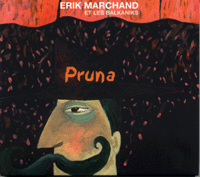
ERIK MARCHAND ET LES BALKANIKS
PRUNA (Le Chant du Monde 274 1260)
I was not really sure what to make of this record, which means I had to listen to it a few times. That is not a bad thing as it's easy to dismiss strange discs after one listening, but there's enough here to intrigue me. It's a hybrid of Romany music with French Breton traditional music. The leader of the band is the vocalist with appropriately rough Gauloise-et-café-noir pipes, and his French cohorts are a bombarde player (reed instrument like a clarinet) and a violinist. He shores them up with Taraf de Caransebes from Roumania, featuring horns, bass and accordéon. A second accordéonist from Serbia joins the fun, as do a Moldavian cymbalum player and a pair of Turks on clarinet and percussion. So it's a real Eurospread of sounds. I can't tell which part is Breton, it mostly sounds like speedy gypsy music to me, but the players are all accomplished, especially the accordéonists, and there are no gratuitous effects, samples, drum machines or rappers to foul it up. There are a couple of strange entries: a fado by Carlos Paredes, that starts with a nice atonal jazz feeling with a strong horn arrangement. There are Arabic and Greek themes that show Marchand is a diligent listener to world radio, and he has assembled an interesting sound collage with strong Rom players at the heart.
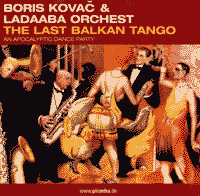
BORIS KOVAC AND LADAABA ORCHEST
THE LAST BALKAN TANGO (Piranha CD1573)
I'm really taken with a CD on the ever-excellent Piranha label from Germany. Boris Kovac and Ladaaba Orchest THE LAST BALKAN TANGO, subtitled "An apocalyptic dance party," posits the question, "Just imagine there is only one starry night left till the end of this world... what would we do?" The answer is provided on this album: Party like there's no tomorrow! Though it's burdened by the tragic events which have overshadowed the lives of the inhabitants of the eastern coast of the Adriatic, this album dances in joy. There's more than a touch of the "duende syndrome": the notion that suffering brings out great musical expression. This group was put together to provide a heartening blend of all the musical and cultural influences of the region, so there are touches of Gypsy, Serbian, Hungarian, Romanian, Slovak, Bulgarian, and Turkish music. There's tango, folk dance, waltz and general rowdiness aplenty. The leader, Boris Kovac, returned to Yugoslavia in 1996, after living in Canada where he also recorded experimental music, and put together the LaDaaba Orchest (Their name stands for La Danza Apocalypsa Balcanica) to create the sound of saloon musicians on the edge. This album succeeds and has a bittersweet finality to it, redeemed by a Fellini-esque ribaldry.
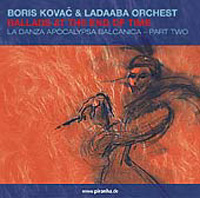
BORIS KOVAC & LADAABA ORCHESTRA
BALLADS AT THE END OF TIME (Piranha CD PIR1787)
I was surprised to see this CD, subtitled La Danza Apocalypsa Balcanica -- Part Two, assuming the band had all committed suicide after volume one, which posited they were partying at the end of time and there was literally no tomorrow. But here's another helping of desperation, this time from the morning after the apocalypse. There's an old Spanish proverb that "Part Two is never any good" (although Don Quixote put the lie to that), so it is with trepidation that I stick this second part of the Dance of Death into the player. It starts theatrically with howling dogs, ominous bowed bass notes, a distant violin, and a tentative clarinet melody: the tension is palpable. After three minutes it snaps and we are in an old-time ballad. The music is very theatrical and doesn't have many traces of Serbian folk music, though the band are based in Novi Sad, the capital of Pannonian Serbia. Chamber music by survivors who never thought they'd be able to sit and tootle pretty melodies again, so their nostalgic waltzes are tinged with sadness. The whole thing is very downtempo and mournful but meditative, with beautiful melodies that occasionally suggest a tango or a samba (except when they make the dogs howl). After an hour of longing and regret we hear some birds singing, so the world is put right again.
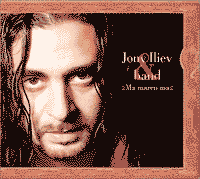
JONY ILIEV & BAND
MA MAREN MA (CD AIR 0102)
The Duchess insists this guy sounds drunk. He does have a warble to his voice and a certain anguished quality, but wouldn't you if you lived in Bulgaria? Gypsies all over Europe are emerging from the shadows in the post-Soviet, post-Yugoslav civil war era. Sofia is one of the grimmest spots. In 1969 I was detained by the Bulgarian border guard for having long hair, suspected of being an anarchist. After a haircut with a pair of tiny manicure scissors which made me look like an escaped mental patient, I was allowed to continue my journey, hitch-hiking across their beautiful country. It was even hard to get bread in Sofia, everything was rationed. It was the greyest place I'd ever been. As there was nothing else to buy, and it was cheap, I purchase a lifesized oil painting of V.I. Lenin and he became my roadside companion as I hitched back across Europe. All of which is beside the point, except to stress what a harsh background this group comes from.
I really like the opening track with its accordion and violin interrupted by a hot lead guitar, and trembly backing vocals. Clarinet introduces a flamenco-style guitar and then ceramic drums take us into a fast number called "Godzilla." Most of the tracks feature what you'd expect: typical Rrom riffs, but the accordeon and guitarist are both fine musicians. Iliev has a husky scruffy quality to his voice which is appealing. The sax player does well on the title cut while the guitarist creates some inventive wah-wah waffle in the background. I imagine this band will improve with age but it's a good debut and bound to please fans of traditional gypsy music. It gets a little gypsy-kitsch at times but manages to keep it together, ending with an instrumental version of the title cut where the musicians get to stretch out once more.
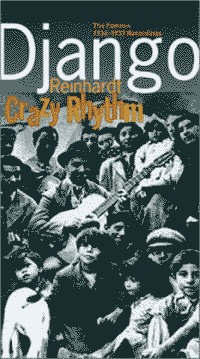
DJANGO REINHARDT
CRAZY RHYTHM "The famous 1936-7 recordings" (IRIS music 2003 2CD 3001 854)
Everyone knows Django, the gitane who heard some American jazz records in 1931 and revolutionized gypsy music while inventing jazz guitar. Django damaged two fingers on his left hand in a fire in his caravan so had to create a new way of playing which caused him to develop a technique of fast runs. He had a long association with violinist Stephane Grappelli and, while I dont particularly relish the combination of instruments, there's no denying the beauty of this music. In fact I realised I was blaming Grappelli for being merely good, which is sad given that he was in the presence of a genius. It's like saying Charlie Rouse is not a great sax player -- but he did keep up with Monk and their partnership worked great. I once owned the boxed set of DJANGOLOGY which was an exhaustive collection of his tracks, but it was also exhausting because he cut so many sides with mediocre French singers of the thirties. Every time you thought a session was about to take off it would end, and Django would be thrust back behind some other sub-Crosby crooner.
Now Iris music has given us pure unadulterated Django and some fine moments too. In fact the version here of Cole Porter's "In the Still of the Night" is sublime. The acoustic bass lays down a tempo and the guitar and violin solo in turn (with Django being really tricky and reminding me of the "Dieu de la guitarre", Docteur Nico, who plucks unexpected ideas from the air), then they converge for a rousing last chorus and melt the grooves. It has the best final thirty seconds of any record I own (excepting perhaps the outro to "Odongo" by Franco and Sam Mangwana). The whole track is barely three minutes long with one key change, a typically deceptive Porter ploy. In fact he's the most complex of American composers.
The repertoire is mostly Tin Pan Alley, one of my favourite haunts, encompassing everything from Duke Ellington to Franz Liszt's "Liebestraum." There are two discs in this handsomely presented set. Half of the second disc includes blowing sessions with guest musicians including Coleman Hawkins' orchestra & trombonist Dicky Wells and his orchestra. But these are not all super-sessions, as you sense the musicians are just enjoying playing in each other's company. However the "Honeysuckle Rose" and "Crazy Rhythm" are brilliant examples of Coleman Hawkins' form before he quit Europe to return to the USA and fame in the 1940s. Another highlight is Hawkins doing "Out of Nowhere" in which Grappelli plays piano; there's no guitar but a banjo. Is that Django? In addition to a photo of Django with Fred Astaire, there are shots of trumpeter Rex Stewart and bassist Slam Stewart in the booklet, but neither of these gents is heard here, so perhaps there are more volumes on the way. The recordings actually span the years 1936 to 39 so there's more puzzlement. The second volume is interesting but there's less Django on it than on the first which is all the Quintet of the Hot Club of France. A perfect introduction, or a solid addition, to your Django collection.
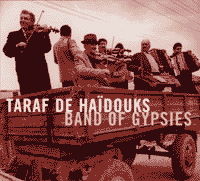
TARAF DE HAÏDOUKS
BAND OF GYPSIES (Nonesuch 79641-2 /Crammed Disc in Europe)
Taraf de Haïdouks returns with a new CD recorded live during three concerts in Bucharest. BAND OF GYPSIES features all new material, and the virtuosi not only kick out the jams, but bring in some really stupendous talent to add to the fireworks. Elsa Dahmani (22-year-old daughter of Tony Gatlif, director of LATCHO DROM) shot a documentary on the group during the concerts which can be seen on THE CONTINUING ADVENTURES [reviewed above]. This was the band's first ever performance in the capital of Romania as they had previously been ostracized there. At first the anti-gypsy sentiment even caused the concert to be cancelled -- the authorities have their own "official Gypsies" who appear on the folk tv station singing schmaltzy ballads in "ethnic" garb. It's fakelore rather than folklore as the songs have been transcribed and are to be sung as written without improvisation. Taraf were unique in that the band was assembled by French producers who traveled to Clejani, having heard that's where the gypsy musicians lived, and hired the best on the spot for a tour. But while they were authentic gypsy musicians they had their own individual modes of expression so the group was by no means characteristic; some of them might even by called eccentric. Rather they are the current state of the evolving tradition. Once the local media learned that Taraf has played over 1000 concerts all over the world they began to warm up, and started writing about them "in medias res" like they had always been a topic of discussion in the Romanian press. The great 10-man brass band Koçani Orkestar drove up from Macedonia (500 miles) in a van with all their instruments to appear alongside their fellow Rom. As none of them has a common tongue, everything had to be communicated via gestures and bits of melody.
There's tear-jerker ballads with plinkety cymbalum and pleading violin accompaniment, and of course the raucous accordions, thudding double bass and pennywhistle. A real kick is Taraf's version of "Carolina," a classic Jamaican folk number, covered by Prince Buster and most recently a dancehall hit for Shaggy, as "Oh, Carolina!" in 1993.
The album, which is known in Europe as BRIDE IN A RED DRESS, opens and closes with an eerie sound as Neculae Neacsu jerks a horsehair attached to the strings of his violin while fingering the neck, a piece of musical deconstruction that makes the connection to another Band of Gypsies.